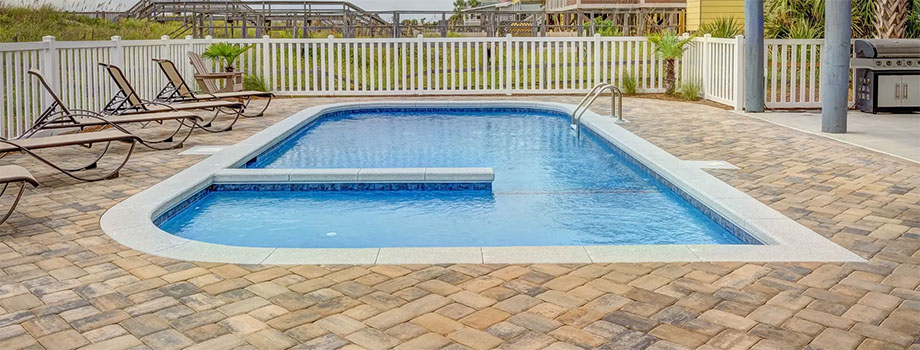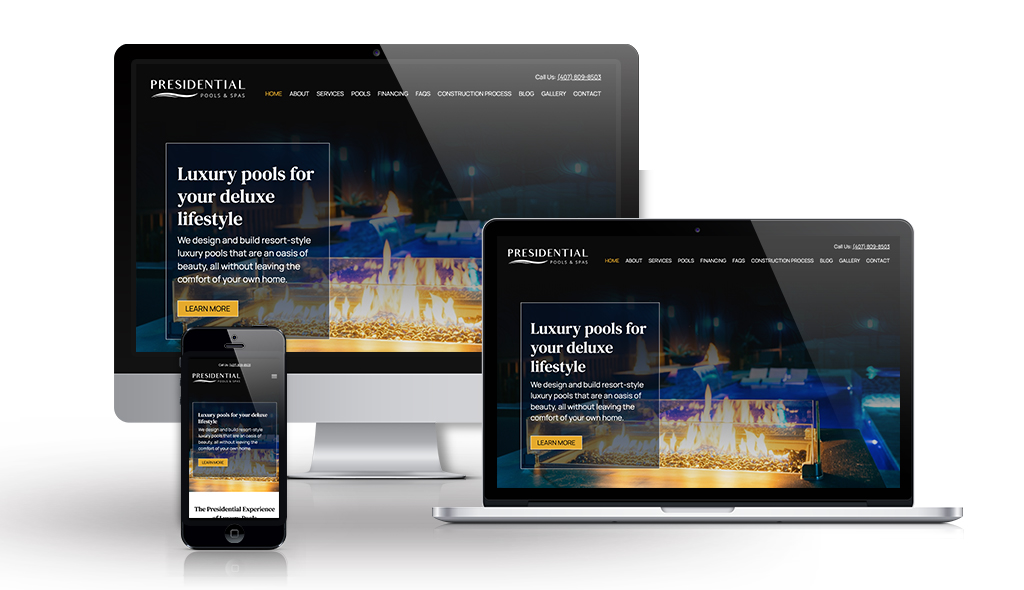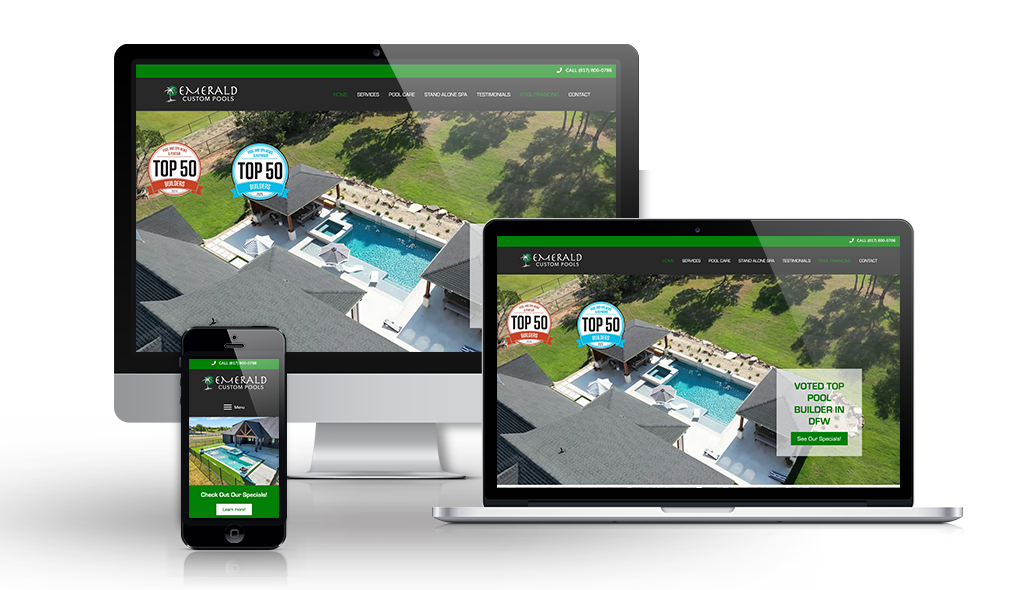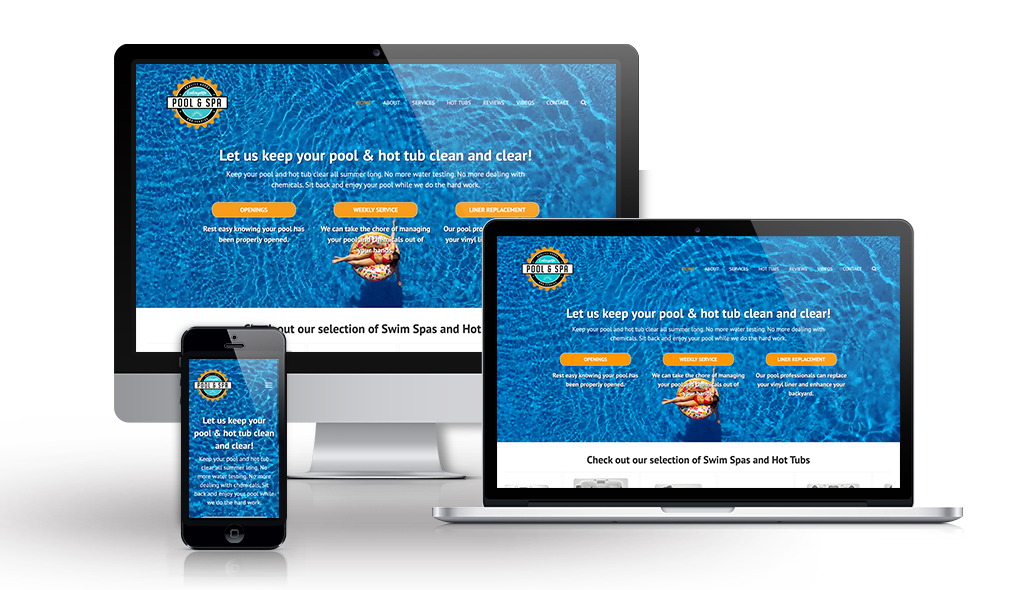
I’m going to start this post with a story. And that story is one of pool builder web design, and how we came to be prolific in that area. In 2010, I bought a house with a pool. The pool… it had some problems. Also, I live in Indiana, I’d never had a pool before, and I knew absolutely nothing about pool care. Being a smaller town, the pool company options were limited. The company that the previous owners had used was not responsive, dismissive, and didn’t do a great job so I was frustrated. There weren’t any other companies I could find online. Then one day I was driving home and was behind a truck that had the name and logo of a pool company I’d never heard of. I considered following this truck and accosting them, but I didn’t. Instead, I went home and Googled. I couldn’t find them – they didn’t have a website. But I did find they were selling pool cleaning robots on Ebay… and from there, I was able to find an email address.
I sent an email that said something like this: “You are a pool company without a website and I’m a website designer with a pool. Would you like to meet and see how we can help each other?”
He said yes, and to this day we are still friends.
Anyway, that was the first pool builder web design we did. But since then we have done a fair number. Here are a few of the pool builder web designs that are in our portfolio.
I’ve learned a lot in the last 15 years, both about pool ownership and about pool builder web design. Now I want to talk about what your website needs to have if you are a pool builder, what people are looking for when they land on your site, and how to make your website and your business stand out.
The “Must-Haves” for your pool builder web design
If you are a pool builder and have a website, here are the things you absolutely must include on your website.
A Professional Appearance
Having a pool built is not cheap. In fact, getting a new in-ground pool is quite expensive. What does it say about your business if your website looks like it was homemade? I’ll tell you what it says. It says to your customers that you are not getting enough business to afford a professional looking website. If you can’t afford a few thousand dollars for a website, why should someone pay you $50,000 for a new pool?
A professional appearance on a pool builder’s website is absolutely crucial for several reasons, primarily because it directly impacts customer perception, trust, and ultimately, conversions. Here’s why:
A polished website, especially one that showcases a strong portfolio of high-quality images and detailed project descriptions, proves your capability and style. It allows potential clients to visualize what you can do for them and helps them trust your expertise.
First Impressions are Everything: For over 80% of customers, their first interaction with a pool builder will be through their website. A professional, visually appealing, and well-designed site immediately creates a positive first impression and sets the tone for your business. Conversely, a cheap, outdated, or poorly designed website can instantly erode trust and make potential clients question your professionalism and quality of work.
A Professional Portfolio
A pool builder’s website portfolio is arguably the most critical section of your entire online presence. It’s where potential clients go to envision their own dream backyard and gain confidence in your capabilities. Here’s what should go into a compelling pool builder web design portfolio:
1. High-Quality, Professional Photography and Videography:
- Stunning Visuals: This is non-negotiable. Invest in professional photographers and drone videographers. Blurry, poorly lit, or low-resolution images will instantly deter clients.
- Multiple Angles: Showcase pools from various perspectives – aerial shots, close-ups of features, wide shots that capture the entire backyard oasis.
- Day and Night Shots: Highlight how the pool looks at different times, especially with integrated lighting.
- Before and After: When possible, including “before” photos to demonstrate the transformative power of your work is highly effective.
2. Detailed Project Descriptions:
- Project Name/Location (Optional for Privacy): Give each project a unique identifier. You can choose to omit specific addresses for client privacy. But if you want to get caught in those “near me” searches, having this is important.
- Key Features: List out the notable elements of each pool:
- Pool type (e.g., infinity edge, lagoon, geometric, lap pool)
- Materials used (e.g., tile, coping, decking, interior finish)
- Water features (e.g., waterfalls, fountains, sheer descents)
- Lighting (e.g., LED, fiber optic)
- Integrated spas/hot tubs
- Smart pool technology
- Landscaping and hardscaping elements (e.g., outdoor kitchens, fire pits, pergolas)
- Unique design challenges and solutions.
- Client Needs/Vision: Briefly describe the client’s initial request and how you brought their vision to life. This shows your ability to understand and execute specific desires.
- Size and Dimensions: Provide basic specifications where relevant.
3. Diverse Range of Projects:
- Variety of Styles: Showcase different architectural styles, from modern and minimalist to naturalistic and resort-style.
- Different Budgets: While you might primarily focus on high-end, it’s beneficial to show a range if you cater to different price points, demonstrating versatility.
- Complex vs. Simple: Include both intricate, custom designs and simpler, elegant pools to appeal to a broader audience.
- Renovations vs. New Builds: If you offer both, feature examples of both to highlight your expertise across the spectrum.
4. Client Testimonials (Integrated with Projects):
- Specific Feedback: Instead of just a general “great job,” include quotes from clients praising specific aspects of the project showcased (e.g., “The custom waterfall exceeded our expectations,” or “They perfectly captured our vision for an outdoor living space”). When you showcase a pool in your portfolio, and show what the buyer of that pool had to say about their experience, it’s much more meaningful than just having a page of generic testimonials.
5. Clear Navigation and Filtering Options:
- Categories: Allow visitors to filter the portfolio by pool type, style, features, or even budget (if applicable) to quickly find what interests them.
- Easy Browse: Ensure smooth transitions between projects, perhaps with “next” and “previous” buttons or a gallery view.
6. Call to Action (CTA):
- Direct Next Steps: On each project page, include a clear call to action, such as “Request a Free Consultation,” “Get a Quote,” or “Contact Us to Discuss Your Project.” Make it easy for interested parties to take the next step.
A Great About us Page
The “About Us” page on a pool builder’s website is a prime opportunity to connect with potential clients on a personal level, build trust, and differentiate your company from competitors. It’s not just a place for dry facts; it’s where you tell your story and establish your unique value proposition.
Here’s what should typically go on an about page for a pool builder website:
- Your Company Story & History:
- Founding Story: How and why did the company start? Was it a family business, a passion project, or a response to a market need? People connect with authentic stories.
- Evolution & Growth: Briefly describe your journey. How has your company grown and adapted over the years?
- Milestones & Achievements: Mention significant projects, number of pools built, or years in business.
- Mission, Vision, and Values:
- Mission Statement: What is your company’s core purpose? What do you aim to achieve for your clients? (e.g., “Our mission is to transform backyards into personalized aquatic escapes that bring families joy for years to come.”)
- Vision Statement: Where do you see your company in the future? What impact do you want to make? (e.g., “To be the leading innovator in sustainable and luxurious pool design in [Your Service Area].”)
- Core Values: What principles guide your business operations? (e.g., integrity, craftsmanship, customer satisfaction, innovation, sustainability, safety). These resonate with clients who share similar values.
- Meet the Team:
- Key Personnel: Introduce the owner(s), lead designers, project managers, and any other crucial team members. Include professional headshots.
- Brief Bios: For each team member, provide a short bio highlighting their expertise, experience, and passion for pool building. Emphasize their individual contributions to the company’s success.
- Personal Touch: Share a little bit about what drives them, perhaps a favorite aspect of pool building or a personal anecdote, to make them more relatable.
- Your Unique Selling Proposition (USP):
- What Makes You Different? Clearly articulate why a client should choose you over competitors. Is it your specialized design approach, proprietary construction techniques, unparalleled customer service, focus on eco-friendly pools, or a unique post-completion support program?
- Benefits, Not Just Features: Instead of just listing what you do, explain the benefits clients receive. For example, “Our streamlined project management ensures on-time, on-budget completion” rather than “We manage projects.”
- Areas of Expertise/Specializations:
- Do you specialize in certain pool types (e.g., infinity pools, natural pools, geometric designs)?
- Do you focus on residential or commercial projects, or both?
- Do you offer extensive outdoor living space design beyond just the pool?
- Highlight any unique skills or capabilities that set you apart.
- Commitment to Quality & Craftsmanship:
- Explain your approach to design and construction, emphasizing the quality of materials, attention to detail, and adherence to industry best practices.
- Mention any certifications, licenses, or associations you belong to (e.g., PHTA – Pool & Hot Tub Alliance). This builds significant credibility.
- Community Involvement/Sustainability Efforts (Optional but impactful):
- If your company gives back to the community or is committed to sustainable building practices, this is a great place to highlight it. It showcases your company’s broader positive impact.
- Call to Action (CTA):
- Even on the about page, guide visitors to the next step. Common CTAs include:
- “Learn more about our services”
- “View our portfolio”
- “Request a consultation”
- “Contact us to discuss your dream pool”
- Even on the about page, guide visitors to the next step. Common CTAs include:
Those are the “must haves” for your pool builder web design, but what are some “nice to have” items?
Interactive Pool Builder Calculator
Most people who go to have a pool added to their property have literally no idea how much a pool costs. Having an interactive calculator can help people get a baseline for what a pool costs from your company. It doesn’t have to be exact, and it should include a disclaimer that it’s generating a ballpark figure based on some basic choices.
Financing Page
Pools are expensive, and not everyone can write a check for a new pool. If you work with financing companies that help people afford new pools, you should hae a page dedicated to that. Let people know that a new pool is affordable.
Other Services
Do you offer pool repair? Weekly service? Product delivery? You should have a page dedicated to each of your additional services.
A Blog
One of the best ways to attract traffic to your website is with a blog. Writing new content about your process, latest trends in pools, and any other topic related to pool builder is invaluable.
An FAQ page
I’m willing to bet that as a pool builder, you get asked a lot of questions. Save yourself time on the phone or in emails by answering all those questions on your website.
Your website should not be an after thought. A well-designed website for your pool builder business is essential to attract new projects and establish your business as an industry leader.
Amy Masson
Amy is the co-owner, developer, and website strategist for Sumy Designs. She's been making websites with WordPress since 2006 and is passionate about making sure websites are as functional as they are beautiful.



